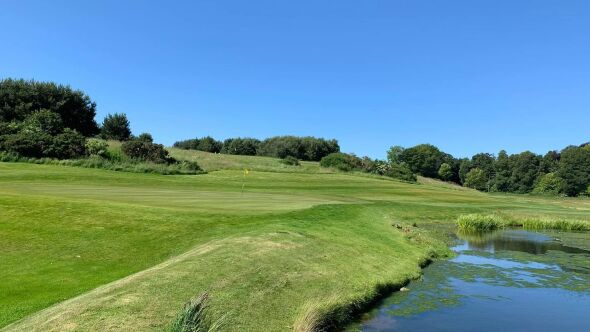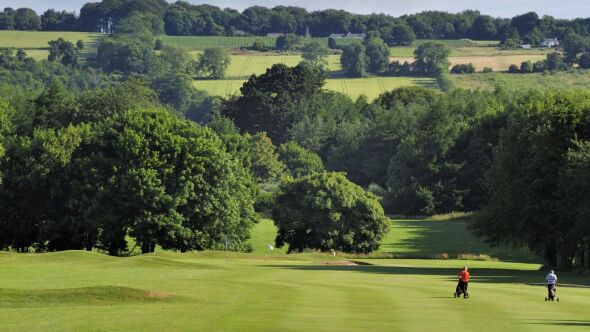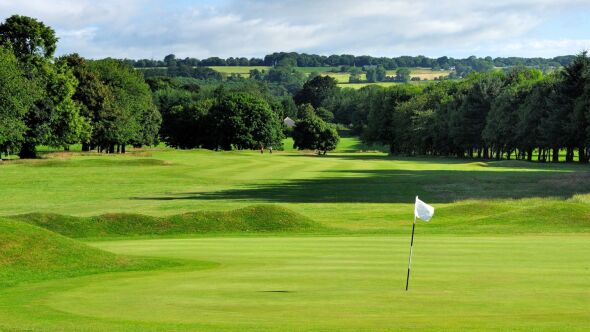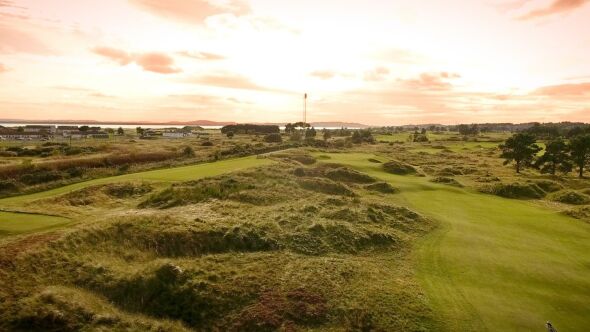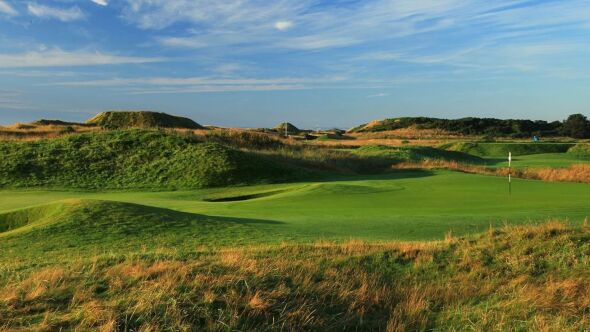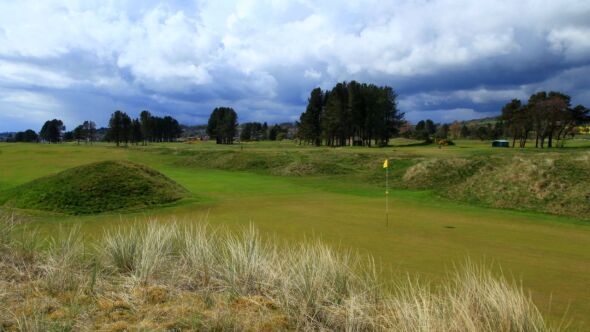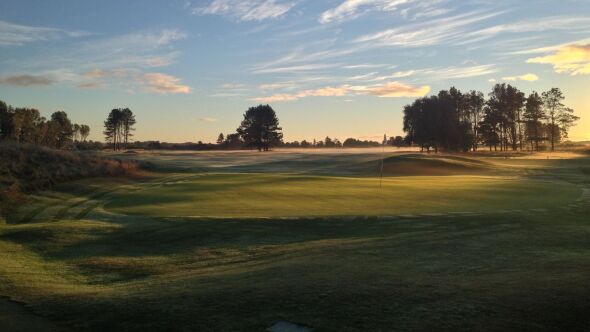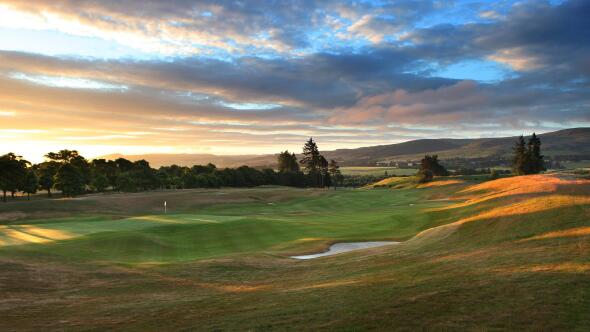Carnoustie Golf Links - Championship Course

About
One of Scotland's most infamous courses is Carnoustie Championship Links in Angus.
It's a regular host to the British Open and has seen winners including Ben Hogan, Gary Player, Tom Watson and most recently Padraig Harrington in 2007. But its recent lore belongs to who didn't win it, Frenchman Jean Van de Velde, after his infamous triple bogey collapse on the 72nd hole in 1999. Play the diabolical 18th yourself however, and it's easy to sympathize with the Frenchman.
For golfers staying in nearby St. Andrews, Carnoustie is less than an hour's drive away, making it easily includable in any Fife golf tour.
| Tee | Par | Length | Rating | Slope |
|---|---|---|---|---|
| White | 72 | 6945 yards | 75.2 | 139 |
| Yellow | 70 | 6589 yards | 73.6 | 135 |
| Green | 70 | 6139 yards | 71.5 | 130 |
| Green (W) | 74 | 6139 yards | 77.3 | 140 |
| Black | 70 | 5610 yards | 69.1 | 126 |
| Black (W) | 71 | 5610 yards | 74.4 | 135 |
| Hole | 1 | 2 | 3 | 4 | 5 | 6 | 7 | 8 | 9 | Out | 10 | 11 | 12 | 13 | 14 | 15 | 16 | 17 | 18 | In | Total |
|---|---|---|---|---|---|---|---|---|---|---|---|---|---|---|---|---|---|---|---|---|---|
| Yellow M: 73.6/135 | 389 | 407 | 325 | 364 | 369 | 500 | 373 | 157 | 416 | 3300 | 417 | 351 | 407 | 141 | 459 | 437 | 235 | 421 | 421 | 3289 | 6589 |
| Green M: 71.5/130 W: 77.3/140 | 364 | 382 | 310 | 358 | 350 | 485 | 350 | 133 | 402 | 3134 | 332 | 330 | 395 | 121 | 440 | 418 | 212 | 374 | 383 | 3005 | 6139 |
| Handicap | 10 | 4 | 14 | 16 | 12 | 2 | 8 | 18 | 6 | 3 | 15 | 9 | 17 | 1 | 7 | 13 | 5 | 11 | |||
| Par | 4 | 4 | 4 | 4 | 4 | 5 | 4 | 3 | 4 | 36 | 4 | 4 | 4 | 3 | 4 | 4 | 3 | 4 | 4 | 34 | 70 |
| Handicap (W) | 9 | 3 | 11 | 7 | 5 | 1 | 15 | 17 | 13 | 8 | 14 | 4 | 16 | 2 | 12 | 18 | 6 | 10 |
Course Details
Rentals/Services
Practice/Instruction
Policies
Food & Beverage
Snacks, RestaurantAvailable Facilities
ClubhouseReviews
Reviewer Photos
Perfect
I don't care that the course was difficult and kicked my butt. I don't care that the course was saturated in areas and rained on a little throughout the round. This place is perfect. The layout is awesome and the conditions were amazing. Especially for the amount of rain it had received in the prior days. The staff and hospitality were amazing as well.
Championship Course visit
The £270 green fee is daylight robbery. The Course is super, but does not justify that cost. They are only interested in getting your money. Don’t book as a single player as they put you out behind a 4-ball without any thought or question.
Also don’t bother giving them any feedback post visit as you’ll get no reply!!!
Avoid this place like the plague now. Spend your money on much better Courses elsewhere. They are living on their Open reputation and it stinks!!
I will never return.
Terrible Customer Service
Terrible Customer Service
Review of Carnoustie Golf Links
Pending review
In Scotland on my bucketlist golf vacation! Carnousite was scheduled for our last day. We went through Bonnie Wee Golf for the package we were on. As REALLY BAD luck would have it, I hurt my back on day 2 and was unable to continue. All the courses I did not get to play either gave me a refund or at least a voucher I could use on a future date. So what did I get from Carnoustie.... NOTHING! And lots of it! Our tour director from Bonnie Wee Golf reached out and then I did as well. Basically I got a "sorry for your injury, but we don't owe you anything". I will go back to Scotland again, but I will NOT visit Carnoustie! Wish I could give it a ZERO!!
Nasty Scot Charm of Members and Caddies
Was on trip that included St. Andrews and Royal Dornach. Both exquisite courses run by good people.
Always wanted to play Carnoustie. Checked into Links Hotel which was quite nice. Had great weather and was paired with good people for our round. But, that is all the nice that I can say about my Carnoustie Golf Experience.
It began as I was leaving the club house to start the round when greeted (or should I say ignored by two members who felt it fit, to not only do the polite things and hand me the door as i walked behind them, but, actually went out of their way to be sure to avoid touching the door at all so it shut in my face. It something you might see a child do when not properly taught manners, it's not something an grey haired pair of "supposed gentlemen" would do to a guest at their club.
But, I shrugged that off and got to the first tee. About 3 holes in the fun began, caddies with group behind let their foursome tee off while my group were still preparing to hit our 2nd shots. As "FOUR" rang out, a ball sailed over my head. We turned with a wave and proceeded to set-up for our shots and anouther FOUR rings out and another ball bounced behind me and hit my pull-cart.
Folks once can be a mistake, twice is a message. Shaken, I stood over my ball and in my back swing a 3rd shot came over my head.
Now, I had a friend get hit with an errant shot, he lost an eye. Caddies should know better, their players are THEIR responsibility a visitor probably doesn't know the distance, a caddie surely does. The caddies (and their were 4 of them in that group) simply didn't care if a guest got hurt.
Balls sailed over our heads 3 more times during the round culminating with a shot on Hole 16 that literally bounced on the green and rolled off as we were putting.
Myself and one of the guys that I was paired with reported the incidences and complained at the Pro Shop. Apologies were offered, if only halfheartedly.
I will not be playing Carnoustie again. I recommend that you avoid it on your Edinburgh golf swing. There are better places to play and far better places to be charmed by the great treatment that you get when members and caddies recognize that it's visitors like us that keep their dues down and their employment intact.
Clearly, Carnoustie is one of those places where the locals don't really need your business. So, my advice is watch it on TV and enjoy the other great courses in Scotland. The town has little else to offer, as well, so you won't be missing much there, either.
Toughest closing holes on the planet
Nobody comes to Carnoustie for the views. It has an entirely inland feel, with the water’s edge coming only as close as 1,000 feet at one point behind the second green. It’s a grimy landscape with only 20 feet of elevation change across the site.
No, players come to Carnoustie for the four-hole closing stretch. If they come any tougher, I want no part of it.
Carnoustie is perhaps the best example of how good a course can be on a piece of land that isn’t overly impressive. Between the meandering burns and OB stakes, there is a hazard in play on 13 holes. Further, 15 of the the 35 full-swing strokes entail the risk of OB, a burn or both. On nine of 14 drives, players need to be mindful of what not to do. That is a recipe for nervous play.
The wind is almost always a factor here, and the firm, fast conditions of the fairways and greens make the ball roll and roll. The fairways are narrow. Bunkers become vacuums. The greens are generous, but they are undulating.
Carnoustie seems to want you to struggle. For 14 holes, one can seem mired in an endless cycle of recovery shots that eventually wears one down. And when you think you’ve had enough, you stand on the 15th tee and prepare for four blood-letting holes.
It is devilish. But then again, that is why you came.
My favourite Links course!!
This was our 2nd boys trip to Scotland and for a 2nd time it did not disappoint!! I loved Carnoustie the first time I played it, and I enjoyed more this time. The course was in amazing shape, and we lucked out with great weather again. We had a small lunch at the Carnoustie Golf Club across the street and enjoyed a nice dinner at the hotel behind the 18th green. If I ever do another trip to Scotland, it will be a must play again!
Not a Must-Play Course
If you go to Scotland determined to play an Open course (I was), and if Carnoustie is your only chance to make that happen (it was for me), then play Carnoustie.
But if you have other Open courses available to you, or if you don't care about playing Open courses one way or the other, then you should seriously consider skipping Carnoustie. Scotland has a wealth of must-play links courses that offer transcendent experiences, and Carnoustie just isn't one of them.
That's not to say it's not a terrific course. It is. It's brutally challenging, and it's easy to see why it makes a terrific test every time the Open visits. But it's not beautiful, quirky, or really even fun. It's just one body blow after another for four-plus hours.
I gave five stars because I'm not sure it'd be fair to punish Carnoustie for something other than whether it's a great course. And it is. But it's not the sort of place that makes you think, "Man, I've gotta bring my kid here to see this one day." It doesn't tug at your heartstrings. I enjoyed my round and was proud of my score at such a difficult track, but I probably won't go back.
As good as it gets
One of the world's most famous golf destinations didn't disappoint. Outstanding golf course that everyone in our group enjoyed, from scratch to higher handicappers. The caddies provided great information and even better stories and course history lessons.
A walk through history
World Ranking 31, Scotland 5
Carnoustie does not let you relax. Every shot from tee through green requires planning and execution. If you try to “hit-and-hope” here, your hopes will not be fulfilled.
In essence, you play each hole backwards. Figure out first where you want your approach to finish, then where you need to it your tee-shot to give you a chance to fulfill your 2nd-shot plan. Oh, and you may want to figure out how to best avoid all those bunkers, burns, heather and gorse with your tee-ball.
Golf has been played over the links at Carnoustie since the 1500s, The present course came into being in 1850, when it was designed by golf’s first professional, Alan Robertson of St Andrews. Some 20 years later Old Tom Morris tweaked and extended the course to 18 holes (4565 yards).
The first British Open Championship at Carnoustie was played in 1931 — won by Tommy Armour. Prior to the 1937 Open Championship the final 3 holes at Carnoustie were redesigned by James Wright, a local man, and he produced what has come to be regarded as the toughest finishing stretch in golf. The 16th is a 250-yard par-3. In the 3rd round of the 1968 Open Championship, the hole was playing directly into the wind. Jack Nicklaus, who hit driver, was the only man in the field to hit the green in regulation. In 1975, 5-time Open Champion Tom Watson failed to hit the 16th in regulation in all five rounds he played — including during the Monday play- off win over Jack Newton. In fact, Watson made bogey 5-of-5 times.

 While you’re laboring around one of our game’s most demanding courses, you’ll enjoy the history you’re sharing with so many of the game’s greats. In 1953, Ben Hogan decided to travel to the U.K. for the first time to play in the Open Championship at Carnoustie. He won famously, thus completing the Hogan Triple Crown after triumphing at both The Masters and the U.S. Open that year.
Though the Scots adored the “Wee Ice Mon”, he wasn’t too keen on the course. It was his first, and last, appearance at the British Open. “I’ve got a lawn mower back in Texas, I’ll send it over,” Hogan said after winning.
Jack Nicklaus certainly was not enamored by Carnoustie at first. This is what he said in 1983: “When I first went to Carnoustie in 1967 to play a television match with Arnold and Gary, I thought Carnoustie was the worst golf course I’d ever seen. And by the time I’d finished the Open in 1968, I thought it was the hardest golf course I’d ever seen, but a darn good course, and I really had great respect for it. and the last time I went back in ’75, I had even greater respect for it. Now Carnoustie is one my favorites.”
The 6th at Carnoustie is a wonderful 570-yard par-5 and the home of the very first “Hogan’s Alley.” There is out-of-bounds all the way down the left side; and on the final day (two 18-hole rounds), Hogan decided the best position off the tee was between the OB left and the bunkers that normally guard the left side of the fairway. He started his drive left of the fence and cut it back into play, left of those bunkers. Actually, I should say “drives,” plural. Because you see, as legend has it, in his second round that day his drive at 6 stopped right next to the divot hole where his first drive had ended up in his morning round.
Of course, when you play the 18th, keep in mind the 1999 finish of Jean Van de Velde and his painfully famous finishing triple-bogey that cost him the Claret Jug. If you feel the urge, play the hole with just a 7-iron for your first two shots and see if you can make the double-bogey 6 which would have won Van de Velde the Open.
.
Quite possibly Britain's most difficult links
Carnoustie is not romantic, it does not whisper sweet refrains of the joys of a life lived without constraint. In many ways, it is perfectly fitting that this was the course where Ben Hogan won his one and only Open Championship in which he competed in 1953 (the Scots named him “the wee Ice Man” that week). Like Hogan, Carnoustie is a course that we want to love and to understand it’s mystery; it’s mystic, but it remains emotionally indifferent in guiding us down our pathway to discovery.
Carnoustie is described as the most difficult course in all of Great Britain and it may well be if the winds of fate turn against you. From the par 5, 6th (“Hogan’s Alley”) to the finishing holes that posses the subtlety of a punch in the jaw, Cournoustie could not care less about your sense of inspiration, yet you will depart inspired none-the-less.
There are prettier Open Championship courses...
Don't get me wrong, I enjoyed my round on Carnoustie, getting brutalized at every turn by its massive pots, narrow fairways and sinister greens. I just tend to favor more scenic links in Scotland like Royal Dornoch, North Berwick and Cruden Bay. History abounds at every turn here. Playing the closing holes at Carnoustie, thanks to the infamous Wee Burn, are no picnic, just be happy to escape without having to partially disrobe like a certain Open Championship competitor. Good thing the hotel and bar were built in recent years, so a pint or two is nearby. You'll need one after playing here.
By the way, I'm happy to report I carded a tidy 7 on 18 just like Mr. Van de Velde.








 Back
Back






